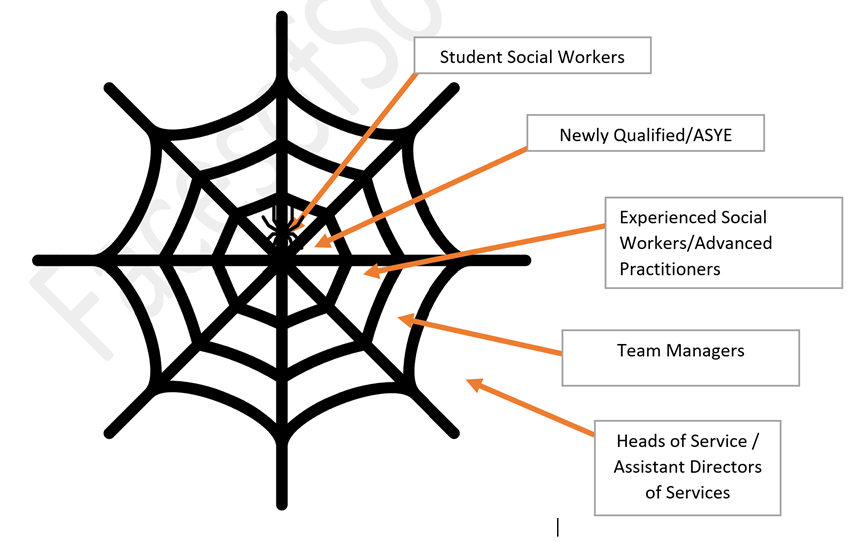The world of social work is like a web, with interconnected layers representing the various fields in which one could practice and the different levels of experience professionals bring to the service. As you progress through your career, you may find yourself moving between different “rings” of this web. Each ring has its own set of expectations, opportunities, and challenges.
Transitioning between these rings may, at times, be a positive experience, but on other occasions, it may be involuntary. The relational dynamics within the workplace and the organizational culture can also influence these transitions, shaping the paths available to social workers.
The diagram below visually represents the different levels or “rings” within the field of social work. It shows how individuals at varying stages of their careers—from student social workers to heads of service—interact within the “web,” progressing through different roles. Each ring holds distinct responsibilities, and the journey between them is not always straightforward.
The image below portrays the intersectional layers within the field of social Work, at its inception.
The image above depicts the layers of progression within the profession, from student social workers starting their careers to heads of services making strategic decisions that affect entire organizations. As you move through the web, each role brings its own set of expectations, challenges, and opportunities for growth.
Do Titles Matter?
What distinguishes one title from another? How do responsibilities shift as you move through each ring of the web? Does this transition impact the overall management of a service? What happens when individuals are rapidly promoted? Are these promotions based on skill, or do factors like preferential treatment play a role? These are just some of the questions we will explore in our upcoming FACE2FACE Podcast discussion.
Reflection on Career Transitions
As shown in the diagram, the transition from one “ring” to another can have a significant impact on a social worker’s professional life. Some may transition voluntarily as they seek to take on more responsibilities, while others may move due to factors such as organizational needs, office politics, or career setbacks. The expectations differ at each stage:
- Student Social Workers begin at the center of the web, gaining hands-on experience in a supervised environment.
- Newly Qualified/ASYE Social Workers enter their first year post-qualification, focusing on consolidating their skills while under supervision.
- Experienced Social Workers/Advanced Practitioners typically work with more complex cases and may begin to take on supervisory or mentoring roles.
- Team Managers have the responsibility of overseeing teams of social workers, ensuring that cases are handled effectively and that team members receive support and guidance.
- Heads of Service/Assistant Directors of Services play an essential role in strategic decision-making, shaping policies and services at the organizational level.As individuals progress through these rings, relational dynamics in the workplace—such as peer relationships, management support, and organizational culture—can influence their career trajectories. These dynamics may either facilitate or hinder career progression, and transitions between roles may be positive or involuntary, depending on the situation.
Conclusion
The web of social work is complex and ever-changing, with different opportunities and challenges at every stage. The question of whether titles matter is not just about hierarchy—it’s about how responsibilities evolve, how individuals navigate transitions, and how each role contributes to the success of the service as a whole.


